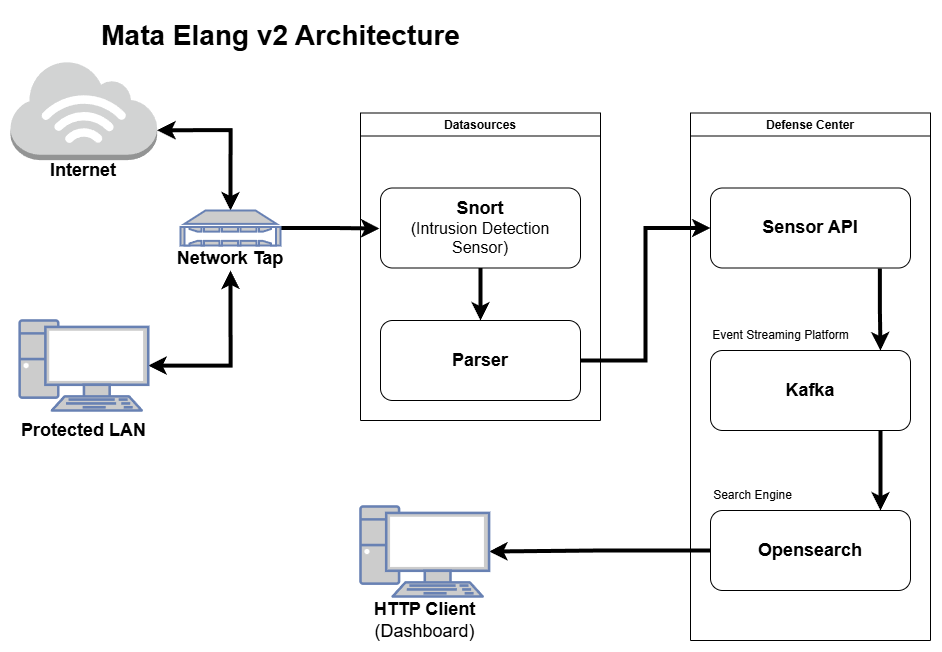Introduction


Mata Elang is the evolution of the Mata Garuda Internet Monitoring Project for Indonesia. This project was initialized as a private repository in 2018 by Cyber Security Research Group (CSRG) - Politeknik Elektronika Negeri Surabaya (PENS). Currently, Mata Elang is a collaboration research between PENS, Universitas Indonesia (UI), and Badan Riset dan Inovasi Nasional (BRIN)with supports from Japan International Cooperation Agency (JICA).
Key Features
- 🚀 Effortless Setup: Mata Elang provides a seamless deployment experience using Docker Compose, making it easy to install and manage across different environments. Whether you're deploying on a single machine or a cloud-based infrastructure, the setup process is streamlined to reduce complexity and ensure a quick start.
- 🔍 Advanced Intrusion Detection with Snort: At its core, Mata Elang integrates Snort, a leading Network Intrusion Detection System (NIDS), to monitor and analyze network traffic for potential threats. It leverages real-time packet inspection and rule-based detection to identify malicious activities and security breaches.
- 📊 Big Data Analytics for Threat Intelligence: Unlike traditional NIDS solutions, Mata Elang is built on a Big Data platform, allowing it to process and store massive amounts of network traffic data efficiently. This ensures better detection accuracy, supports long-term trend analysis, and enables real-time correlation of security events.
- 🏗 Scalable & Distributed Architecture: Mata Elang is designed for scalability, enabling security teams to deploy sensors across multiple network nodes. Its distributed architecture ensures that even high-traffic networks can be monitored efficiently without performance bottlenecks.
- 🛡 Real-Time Threat Detection & Response: By leveraging machine learning and behavioral analysis, Mata Elang can detect anomalies in network traffic and provide real-time alerts. The system is capable of adapting to new and evolving cyber threats, offering a proactive approach to network security.
Project Architecture

Component Functionality
Network Traffic Monitoring
- Network Tap: This component passively captures incoming and outgoing network traffic from the Protected LAN (internal network) and sends it to the Snort Intrusion Detection Sensor for analysis.
- The goal is to monitor all data packets without interfering with normal network operations.
Intrusion Detection & Data Parsing
- Snort (Intrusion Detection Sensor): This is the core detection engine responsible for analyzing network packets and identifying potential security threats based on predefined rules.
- If Snort detects a suspicious packet, it forwards the information to the Parser.
- Parser: Extracts relevant metadata from Snort alerts and converts it into a structured format for further processing.
Data Transmission & Processing
- The parsed data is sent to the Defense Center, which is responsible for storing, processing, and analyzing threats using scalable big data technologies.
- Sensor API: Acts as an intermediary that receives data from the sensor (Snort) and ensures secure data transmission to the backend processing components.
Event Streaming & Threat Intelligence
- Kafka (Event Streaming Platform): Kafka acts as a message broker, ensuring that Snort-generated alerts are processed in real time.
- It allows high-throughput data streaming, making the system scalable and responsive to large volumes of traffic data.
Reference
This project is based on the research that you could read the article here
@article{saputra2022next,
title={The Next-Generation NIDS Platform: Cloud-Based Snort NIDS Using Containers and Big Data},
author={Saputra, F.A. and Salman, M. and Hasim, J.A.N. and Nadhori, I.U. and Ramli, K.},
journal={Big Data Cogn. Comput.},
volume={6},
pages={19},
year={2022},
doi={10.3390/bdcc6010019}
}
